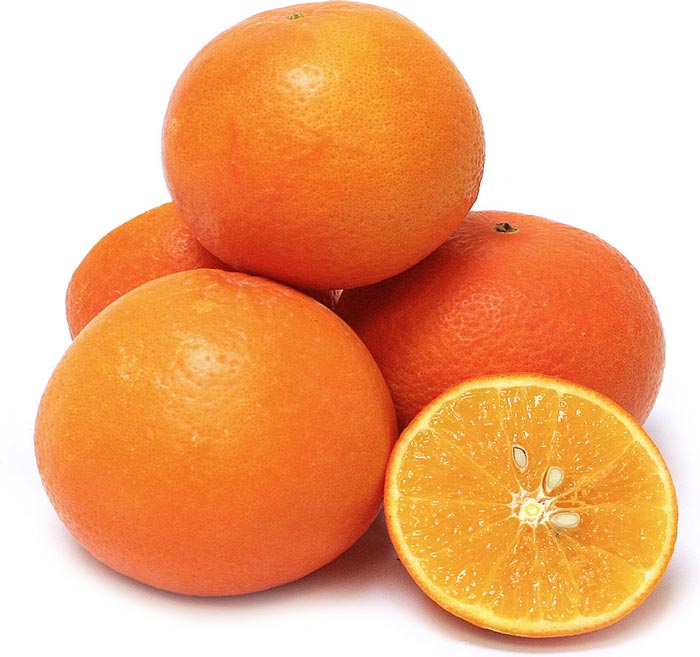Temple Orange
- By The FruitGuys
- Last Updated On
- Reading Time: 3 mins.

Although the Temple orange is certainly tasty enough to offer up to the gods, it wasn’t actually named for a house of worship. Instead, it got its moniker from Florida orange grower William Chase Temple—but we’re getting ahead of ourselves. Before we get into the Temple’s history, let’s start with the basics.
What is a Temple Orange?
The Temple orange is a tangerine and orange cross also known as the Royal mandarin. It has loose skin for easy peeling and sweet pulp with a hint of spice. Temples are typically medium to large, with a bright red-orange, semi-rough rind.
When are Temple Oranges in Season?
Temple orange season is short and sweet. Keep your eyes peeled for them in January and February. Here at The FruitGuys, we add Temple oranges to our seasonal fruit boxes to celebrate their juicy bounty while we can.
The Nutritional Value of Temple Oranges
Like other oranges, Temples are jam-packed with health-boosting essential nutrients. Here’s a quick look at the benefits you’ll get from eating a medium-sized orange.
- Vitamin C – Crucial for immune support and skin health
- Vitamin A – Important for vision and immune function
- Vitamin E – Helpful for protecting cells from oxidative stress
- Folate – Essential for DNA synthesis and red blood cell formation
Thanks to these nutrients, Temple oranges are a healthy addition to any diet.
The History of Temple Oranges
Okay, now it’s history time! Temple oranges likely hail from the West Indies. They arrived in Florida in the 1900s and quickly became prized for their juicy texture, zesty flavor, and affordability.
It’s hard to say what Temple oranges were originally called, but rumor has it the Florida-grown ones were named by grower Louis A. Hakes in honor of his friend and fellow farmer William Chase Temple. The unique citrus fruits initially faced resistance from other orange farmers who worried about their bargain price. But eventually, the Temple’s delicious flavor won out.
The Temple is still beloved today despite its brief season and fragility. In fact, it’s one of only a few eating oranges cultivated in Florida (the state typically produces citrus for juicing). You can also find Temples growing in the Coachella Valley of California.
Recipe Ideas
Here are three recipes to try next time you get your hands on a surplus of Temple oranges.
Grapefruit & Orange Marmalade: If you’re a condiment connoisseur, try combining the zesty flavors of grapefruit and Temple oranges to create a delicious spread for toast or a tangy addition to desserts.
Temple Orange and Olive Salad: Feeling a bit more adventurous? This refreshing and vibrant salad features marinated Temple orange slices, chicory or endive greens, and Kalamata olives, all tied together with a citrusy vinaigrette dressing.
Temple-Orange Tart: The Temple Orange Tart utilizes all parts of the orange—zest, juice, and flesh—to create a beautiful and flavorful tart with a creamy filling.
FAQs
1. What makes Temple oranges unique?
Temple oranges are a delicious hybrid of tangerines and oranges, known for their:
- Easy peeling: Their loose skin makes them a breeze to enjoy.
- Zesty flavor: They offer a unique balance of sweetness with a hint of spice.
- Vibrant color: Their bright red-orange rind never fails to catch the eye.
- Versatility: Enjoy them fresh or in jams, salads, or desserts.
2. When are Temple oranges in season?
Temple oranges have a blink-and-you’ll-miss-it season, typically peaking in January and February.
3. Are Temple oranges good for you?
Absolutely! Temple oranges are packed with essential nutrients like folate and vitamins C, A, and E. These vitamins contribute to immune support, skin health, vision, cell protection, and DNA synthesis, making Temple oranges a healthy addition to your diet.
Want farm-fresh fruit?
We've got you covered.Recent Articles
How to Make Your Workplace More Allergy-Friendly (The Ultimate Guide)
High-Tech Break Room Ideas to Boost the Employee Experience
Win Free Snacks for Celebrating National Fruit at Work Day
2025 Employee Gift Ideas: Fruit Gift Hampers and More
How Managing Less Helps Employees Take the Lead
Subscribe to our Newsletter
"*" indicates required fields



